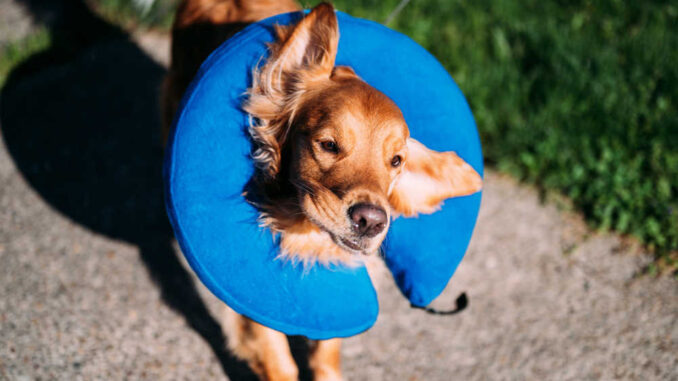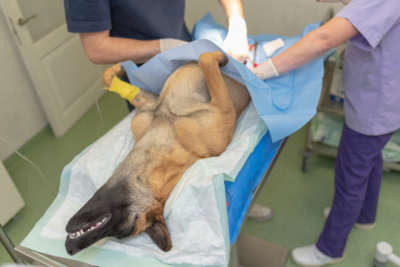
This article was updated on June 1st, 2023
Dog neuters are an extremely common surgery—roughly 80% of dogs in the United States are spayed or neutered. This means that vets are performing them all of the time. As a veterinarian, I average 3-4 dog neuters per week. It’s with this experience that vets are able to send your dog home with such a detailed recovery plan and timeline. If they don’t, read on to find out what the days and weeks following your dog’s neuter will be like for them (and you!).
What is a Dog Neuter Surgery?
For first time dog parents out there, or those that have an inquisitive mind and want a few more details, let’s first go through an overview of what a dog neuter entails. You can call it neutering, castrating, sterilizing, or fixing, either way, it’s the removal of the testicles to prevent reproduction. Along with that, neutering also prevents illnesses such as testicular cancer and prostate problems and can help tame some aggressive and wandering behaviors.

Routine Neuter Surgery
For most dogs, this is an uncomplicated surgery that takes place outside of the body. These are for dogs where both testicles have descended into the scrotum. Your vet will be able to tell if both testicles are where they should be or if he has one or both retained in the abdomen.
After a dog is sedated and put under general anesthesia, the area directly in front of the scrotum is clipped and scrubbed. A veterinarian will don their sterile gear, drape the area, and make an incision in the skin. The testicles will be pushed forward, the cords will be ligated, and the testicles removed. The skin will be stitched up with sutures or staples. Some sutures will need to be removed and some will absorb over the next few weeks.
Cryptorchid Neuter Surgery
A cryptorchid is the word for when one or both testicles forgo the journey to the scrotum. With any luck, your vet will be able to locate the missing testicles just under the skin elsewhere in the groin or near the entrance to the abdomen, called the inguinal canal. The skin incision will then be made in these areas and the surgery goes the same from there.
Some dogs will have still have his testicles inside their abdomen. This becomes a more involved surgery since it requires going into the abdomen more like a spay rather than neatly staying outside the body wall. If this is the case, no problem, but expect a slightly longer recovery period.
How Long Does a Dog Take to Recover From a Neuter Surgery?
Some dogs aren’t even going to know anything happened, and others are going to feel a little off. Either way, most neuter surgeries are considered healed and recovered in two weeks. He’ll be looking at a few days of rest and then restricted low impact activity for the first week. During the second week, he may start to increase activity if everything is going well and be back to complete normalcy by the end of the second week.
Recovery Timeline After Neutering Your Dog

Week 1
Let’s break it down as to how your dog should be feeling and what you both should be doing for the two week dog neuter recovery period.
Day 1:
Some veterinary hospitals will keep your dog overnight following neuter surgery and some will send him home later in the afternoon. Either way, your pup will more than likely feel a little groggy. You may also notice:
- Lack of or decreased appetite
- Slight discomfort
- Decreased energy
You’ll want to give them a quiet place to rest. If it’s the same day as surgery, your vet may advise you to offer small amounts of water and hold off on food until the next morning. This is just because the anesthesia can make him a little nauseous. Give all prescribed pain medications and keep him from licking the incision by using a cone if you have to.
Days 2-3
Give your dog those first few days following surgery to rest. Let him lounge so that he doesn’t irritate the incision or risk puling out any stitches. Feed and water him as normal. If he still has a little nausea from the anesthesia, feed smaller amounts of food more frequently. He may have some bruising around the incision which may be helped by icing for 10 minutes a couple times a day.
Be sure to check the incision at least once a day. There shouldn’t be any swelling, redness, bumpiness or discharge. Contact your vet if you see any of these or if your pup still isn’t feeling back to normal.
Rest of Week 1
If the incision is looking well and your pup is feeling normal, you can go ahead and start to let him exercise some. Just keep it low impact and low level. Leash walks are great. No jumping, heavy running, or swimming. Continue to check the incision and contact your vet if anything seems off. He may still be experiencing a little discomfort and may wince if he makes certain movements but will usually go about his day as normal.
If your pup had a cryptorchid neuter, he may be in a little more discomfort and require a few more days of rest. No worries, though. Just let him move around as he wants with the same kind of exercise restrictions.
Week 2
As long as your pup is still healing normally, you can start to increase his exercise times and levels of intensity. Still try to avoid heavy running, jumping, wrestling or swimming until closer to the end of the week. Keep an eye on the incision and finish up the pain medications if needed.
By the end of two weeks, the skin incision should be healed, staples and removable sutures can be taken out. This goes for a cryptorchid neuter as well. Most vets don’t require a recheck unless you’re concerned about something. Once the skin is healed, your pup is good to go!
Related post: Spay Surgery Recovery Timeline
Disclaimer: This website's content is not a substitute for veterinary care. Always consult with your veterinarian for healthcare decisions. Read More.


Be the first to comment